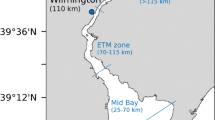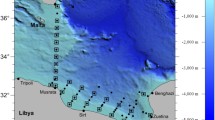Summary
The effect of the variability of mesoscale current patterns on the dynamics of nutrients and plankton is studied by means of a simple coupled model. A chemical-biological model in conjunction with a high resolution circulation model is applied to the southwestern Baltic. The biological model has four state variables; a limiting nutrient, phytoplankton, Zooplankton and detritus. The circulation model is based on an implementation of the GFDL-model in the modular version (MOM 1).
Experimental simulations of a spring bloom with the coupled model show the generation of patchiness, which is basically controlled by the mesoscale circulation patterns in conjunction with sinking of plankton and nutrient limitation. The exchange of material among the sub-basins of the model area and the differences between coupled models and scaled up box models is briefly discussed.
Zusammenfassung
Der Einflu\ mesoskaliger Strömungsmuster auf die Dynamik von NÄhrstoffen und Plankton wird mit Hilfe eines gekoppelten Modells untersucht. Dazu wird ein einfaches biologisches Modell in ein Zirkulationsmodell der südwestlichen Ostsee eingebunden. Das biologische Modell besitzt vier Zustandsgrö\en; limitierender NÄhrstoff, Phytoplankton, Zooplankton und Detritus. Als Zirkulationsmodell wird das GFDL-Modell in einer modularen Version (MOM 1) verwendet.
Experimentelle Simulationen der Frühjahrsblüte des Phytoplanktons mit dem Modell zeigen, wie rÄumlich variable Muster (phytoplankton patchiness) durch die mesoskaligen Strömungsmuster in Verbindung mit dem Absinken von Plankton und NÄhrstofflimitierung entstehen.
Der Austausch von Material zwischen den Teilbecken des Modells sowie Skalierungsaspekte in Bezug auf Boxmodelle werden kurz diskutiert.
Similar content being viewed by others
References
Aksnes, D. L., K. B. Ulvestad, B. M. Balino, J. Berntsen, J. K. Egge, andE. Svendsen, 1995: Ecological modelling in coastal waters: towards predictive physical-chemical-biological simulation models.Ophellia,41, 5–36.
Bodungen, B., K. Bröckel, V. Smetacek, andB. Zeitschel, 1981: Growth and sedimentation of the phyto-plankton spring bloom in the Bornholm Sea.Kieler Meeresforsch., Sonderh.5, 49–60.
Brock, T. D., 1981: Calculating solar radiation for ecological studies.Ecol. Model.,14, 265–293.
Bryan, K.., 1969: A numerical method for the study of the circulation of the world ocean.J. Comp. Phys.,3, 347–376.
Dybern, B. I. andP. Hansen (Eds.), 1989: Baltic Sea Patchiness Experiment-PEX 86. ICES,Cooperative Research Report, No. 163, Copenhagen, (2 volumes).
Fasham, M. J. R, H. W. Ducklow andD. S. McKelvie, 1990: A nitrogen-based model of plankton dynamics in the oceanic mixed layer.Jour. Mar. Res.,48, 591–639.
Fennel, W., 1995: Model of the yearly cycle of nutrients and plankton in the Baltic Sea.Journal of Marine Systems,6, 313–329.
Fennel, W., T. Seifert andB. Kayser, 1991: Rossby radii and phase speeds in the Baltic Sea.Continental Shelf Research,11, 23–36.
Fennel, W. andT. Seifert, 1995: Kelvin wave controlled upwelling in the western Baltic.Journal of Marine Systems,6, 289–300.
Fransz, H. G., J. P. Mommaerts, andG. Radach, 1991: Ecological modelling of the North Sea.Netherland Jour. Sea Res.,28, 67–140.
Goldman, J. C., 1988: Spatial and temporal discontinuities of biological processes in pelagic surface waters. In: B. J. Rothschild (ed.). Towards a theory on biological-physical interactions in the world ocean. Dordrecht: Kluwer, 273–296.
Krauss, W., andBrügge, 1991: Wind-produced water exchange between the deep basins of the Baltic Sea.J. Phys. Oceanogr.,21, 373–384.
Lehmann, A., 1995: A three-dimensional eddy resolving model of the Baltic Sea.Tellus,47A, 1013–1031.
Moll, A., 1995: Regionale Differenzierung der PrimÄrproduktion in der Nordsee: Untersuchungen mit einem drei-dimensionalen Modell. Ber. ZMT, Univ. Hamburg, Nr. 19, pp 151.
Nehring, D., andW. MatthÄus, 1991: Die hydrographisch-chemischen Bedingungen in der westlichen Ostsee im Jahre 1991.Dt. Hydrogr. Z,44, 217–238.
Osborn, T., 1996: The role of turbulent diffusion for copepods with feeding currents.Journal of Plankton Res.18, 185–195.
Pacanowski, R. C. andS. G. H. Philander, 1981: Parameterization of the vertical mixing in numerical models of the tropical ocean.J. Phys. Oceanogr.,11, 1443–1451.
Pacanowski, R. C., K. Dixon andA. Rosatti, 1990: The GFDL modular ocean model users guide version 1.0. GFDL Technical Report No. 2., Geophysical Fluid Dynamics Laboratory, NOAA, Princeton Univ., Princeton, variously paged.
Sarmiento, J. L., R. D. Slater, M. J. R. Fasham, H. W. Ducklow, J. R. Toggweiler, andG. T. Evans, 1992: A seasonal three-dimensional ecosystem model of nitrogen cycling in the North Atlantic euphotic zone.Global biogeoch. cycles,7, 417–450.
Slater, R. D., J. L. Sarmiento, andM. J. R. Fasham, 1993: Some parametric and structural simulations with a three-dimensional ecosystem model of nitrogen cycling in the North Atlantic euphotic zone. In: Towards a model of ocean biogeochemical processes. G. T. Evans and M. J. R. Fasham (Eds.), Berlin: Springer, 261–294.
Smith, S. D. andF. W. Dobson, 1984: The heat budget at Ocean Weather Station Bravo.Atmos.-Ocean.,22, 1–22.
Smolarkiewicz, P. K., 1983: A simple positive definite advection scheme with small implicit diffusion.Mon. Weather Rev.111, 479–486.
Steele, J., 1962: Environmental control of photosynthesis in the sea.Limnol. Oceanogr.,7, 137–150.
Stigebrandt, A. andF. Wulff, 1987: A model for the nutrients and oxygen in the Baltic proper.Journal of Marine Research,45, 729–759.
Wulff, F., A. Stigebrandt andL. Rahm, 1990: Nutrient dynamics of the Baltic Sea.AMBIO,19, 126–133.
Author information
Authors and Affiliations
Corresponding author
Rights and permissions
About this article
Cite this article
Fennel, W., Neumann, T. The mesoscale variability of nutrients and plankton as seen in a coupled model. Deutsche Hydrographische Zeitschrift 48, 49–71 (1996). https://doi.org/10.1007/BF02794052
Received:
Accepted:
Published:
Issue Date:
DOI: https://doi.org/10.1007/BF02794052




